What s the Back of the Boat Called Again
So, you've just purchased a boat, or ameliorate yet, your friend has one, and they invite you lot on a cruise (the joy of OPB: Other People's Boats)! Whether a dusk canvass, an overnight, or an extended take chances, the trip might be more fun if you lot're not completely clueless nigh the parts of a gunkhole, frequent phrases, and other canoeing terminology.
Whether you're hopping aboard for your beginning cruise or want to brush up on your boat terminology (LOA, anyone?), this cheat sheet will help you lot to decipher some on-the-h2o lingo. Read on to familiarize yourself with some of the more frequently used words and phrases translated into everyday English. (Not your kickoff rodeo? Please share this with someone who might need a leg up for their first outing) If you're more of a stowaway than a skipper, finding ways to make yourself useful can go a long mode. Researching and securing dockage or helping keep watch while underway is a smashing identify to beginning. Some terms to know every bit you help float plan: A float plan is a certificate detailing the intended agenda for the gunkhole, including vessel, crew, and equipment information, date of departure, date(s) of arrival, fuel stops, overnights, and dockage/anchorage reservations. A slip is a dock section in which captains park their boats. The dock can refer to the full general area of the marina where the boats tie up ("Let'southward head down to the dock") too the actual flat floating structure itself ("This dock is badly damaged"). A marina'southward docks can encompass its slips, linear dockage, fuel dock, dinghy dock, and sometimes the ship'southward store or office. You lot may find cleats (ideally), electrical hookups, or water hookups nearly your slip. In addition, yous may find a dock cart for toting gear or provisions, an water ice machine, and bathrooms downwardly the dock. As opposed to a slip a boat pulls into, linear dockage is a marina configuration that docks boats by lining them upward end to stop along the dock, one boat's bow to another gunkhole's stern. Also casually referred to as "a mooring," a mooring brawl floats on the h2o's surface and is secured to the harbor bottom typically via a large, heavy, and permanently-installed ballast, cement block, or another immovable weight. Fastened to a mooring brawl generally, is a pennant, which is a length of rope with a loop at the end – the loop not only helps you grab the mooring ball'south pennant using the boat's boat hook, it as well is the loop through which a line will run to secure the boat to the mooring. Different harbors label their mooring balls in different ways, and they vary by the size of vessel they can conform. A piling is a heavy post, like a phone pole embedded into the seafloor and used to secure docks in place or to which boats can be tied. VHF stands for "very high frequency." On boats, the VHF is the onboard radio transmitter. Marinas (and other boaters, harbor patrols, and the Coast Guard) monitor specific VHF channels. One time y'all've reserved your dockage, a captain will put out a radio call on the marina monitors channel to permit them know he is approaching, request a slip assignment if not provided via the app's Conversation function, or ask for assistance. This definition is somewhat controversial. For any captain who has made a marina director'south day more hectic because they fibbed or fudged the numbers, this ane'south for you: The length of a boat's hull where it intersects with the water. A boat's draft is the vertical distance betwixt the boat'southward waterline and the bottom of its keel. This measurement determines the minimum depth of h2o over which a ship tin can safely navigate. Then when you hear "What does she depict?" the question at hand is, "What depth of water is required for the boat to float?" As a captain requests dockage from a marina, the marinas volition likely enquire for a boat's draft as they take the reservation details and often post Mean Low H2o of its harbor and slips so that potential guests can make the call without an extra VHF or telephone call. Your boat'southward beam is the vessel'south width at its widest point. A marina needs to know this to determine the size of the slip they can offer based on the width of your axle. For example, if a marina has just unmarried-vessel slips for boats up to a 16' beam, a large catamaran volition not fit and will need to continue the linear dockage if bachelor. In other contexts, you may hear beam: If a vessel or landmark is abeam, that means it is directly to port or starboard of your boat. If you are sailing on a axle attain, you are sailing a course ninety° off the wind, with the wind abeam. "Man Overboard!" (abbreviated equally MOB) is the term to bespeak to a boat's crew and passengers that someone has gone in the water. If you hear it and take non been assigned another job in the case of this happening, you tin aid past just finding the MOB and keeping a finger pointed at them at all times until rescued. Y'all may be instructed to hit the Man Overboard button, sometimes labeled "MOB," on a boat'south control panel. The lifering–likewise known as a ring buoy or lifebuoy – is orangish, ruddy, or white ring secured to the boat's stern and designed to exist thrown to a person in the water to provide buoyancy and prevent drowning. Some mod liferings are outfitted with water-activated lights and tracking devices to aid rescue at dark. Unlike throwable, liferings accept a long line fastened to them which connects to the boat so that once a MOB catches it, they can be pulled in with less exertion. A throwable is a personal flotation device (PFD) that can be thrown at someone in the water to assistance prevent them from drowning. On recreational boats, they serve a second function as seat cushions. The nail on a sailboat is a spar (pole) along the foot of the mainsail, which improves canvass shape and serves as an attachment point for canvass control lines. The smash is above the cockpit, which ways it's above the crew in the cockpit. Therefore, when sailing, be mindful of where the boom is. If someone screams "Boom!" or "DUCK!" don't look; duck immediately to avoid injury. A lifeline is a wire or cablevision that runs outside the deck, supported by stanchions, to preclude crew or gear from falling overboard. Properly installed, you tin dangle your body – and several others – over a lifeline (and thus, over the side of the gunkhole) and feel confident y'all will not go in the water. Many boats volition have a toerail forth the edge of a gunkhole'southward deck. If when sailing someone asks you to go on the rails, they are likely request you to hike out as far every bit you canover the toerail (or where a toerail would typically be) on the high side of the gunkhole. A measurement of speed in nautical miles per hr. The revolutions per minute on a gunkhole's engine dictates how fast a vessel can accelerate and travel in various sea states. Getting a boat to aeroplane involves physics, which will bebetter explained past Wikipedia... In layman's terms, for a first-time cruiser, know that getting a gunkhole to plane on a powerboat or dinghy may require bringing upwardly the RPMs relatively apace. Heeling is when a sailboat leans over in the h2o as the wind pushes its sails. When heeling, you will exist safest and likely more helpful (even if it's just your weight helping to flatten the boat) on the windward side of the transport. Mostly speaking, the bow is the front end location of the boat, and the stern is the back. The port is to your left when facing the boat's bow, and the starboard is to your correct. You may hear phrases like, "At that place'south a boat to port," "Leave the mark to starboard," or "The gallon of rum is in the starboard aft cabin." Windward is the point upwind from the point of reference (i.east., you or the boat you're on). Leeward is the direction downwind from the indicate of contact. The side of a send that is too leeward is the lee side. On a sailboat that is heeling, the windward side is always the high side, and the leeward side is the side of the boat closest to the h2o. When sailing (particularly racing), someone yelling, "Get to windward!" translates to "Please make your way to the high side of the boat immediately if not sooner." Merriam-Webster defines a winch as "any of various machines or instruments for hauling or pulling; especially: a powerful machine with one or more drums on which to coil a rope, cable, or concatenation for hauling or hoisting." On a sailboat, the crew volition use a winch to hoist or trim a sheet by coiling the sail's sheet or halyard onto information technology for added leverage. Once pulled in by hand as far every bit possible, they'll use a winch handle to trim the sail in the residuum of the mode or to hoist the sail to its uppermost point. The bilge is the lowest section of a gunkhole where water typically collects. If someone tells you to "check the bilge," they enquire you lot to verify (yous may have to lift a floorboard in the chief salon) that there is fiddling or no h2o collected, which tin can weigh a boat down and thus increment drag. If the bilge has water, you can employ a bilge pump to empty it. If e'er you see water coming above the floorboards, let someone know immediately. If you are a smoker, go to the stern (or "go aft") to smoke. If y'all fume anywhere forward of your young man shipmates, the smoke will exist diddled on to them. On some boats, people will relieve themselves off the side of the boat and then every bit to avoid going beneath, opening valves for the head, etc. Always go aft and to leeward to exercise this, and always keep one paw on the gunkhole. If you feel seasick and believe you will exist physically ill, make your mode aft and leeward if it is safe to practice and then. As you do, let your helm know– if, on a sailboat that is heeled over, he may opt to correct the boat (by turning into the wind, luffing the sails–which slows or stops the vessel). Or ask you to go beneath rather than put yourself in a potentially precarious position on your offset outing. A chart represents a sea, lake, or river'due south surface area and nearby coastal regions. Depending on the chart'south calibration, it may testify h2o depth, navigation aids, navigational hazards, and artificial structures such as harbors, locks, bridges, and buildings. Should the boat's navigation system fail, most boats keep paper chart books of the boat's near frequented region aboard. Your boat's course is the direction the vessel is heading or steered; its movement through the water. Your heading is the compass direction in which a vessel is pointing. Your bearing is the compass reading taken off an object in relation to the observer. A compass is a device that always points towards magnetic northward, used for navigation A mark is a fixed buoyage indicator, such as a lighted beacon, a day buoy, can, or mile marking. Click here for the U.South. Declension Guard's excellent guide to navigation aids and right of way rules. ETA is estimated time of arrival. An accurate ETA is like seeing a mermaid in boating: an impossibility that may result from mirage or hallucination just intriguing to ponder and share yet. A dock manus is an employee of the marina or yacht gild you're about to tie upwards to. Whenever possible, dock hands make themselves bachelor to grab lines, aid a vessel in tying upwards or shoving off, reply questions about the marina and surrounding area to the best of their ability, and, if applicative, provide pumpout or fuel service. The hull is the watertight body, normally made of wood, aluminum, or fiberglass. To reduce hull weakening due to water or ultraviolet light, manufacturers or boat owners will pigment a fiberglass boat's hull with Gelcoat, which requires repair if damaged while underway or docking. In canoeing, a fender – typically made out of rubber, foam elastomer, or plastic – is used to cushion the force of a gunkhole as it approaches or remains secured to a dock, a wall, or some other boat, to prevent damage to other vessels, or structures. A fender may be tied to rails, lifelines, or cleats aboard a vessel. A cleat is used to "hand-fend" as the boat approaches or departs a slip or raft-upwards. Merriam-Webster defines a cleat as "a wooden or metal plumbing fixtures normally with two projecting horns around which a rope may be made fast." Cruising, you'll find cleats on board the boat besides as on the dock, and when docking, the bow line, stern line, and bound lines will secure the gunkhole to the dock past making fast a cleat knot on each. On a boat, the words rope and line are not interchangeable. Information technology's simply a rope when cordage wasn't assigned to a task. However, once it's prepped or in use for a specific job (such as securing an anchor to the bow, securing the boat to the dock, or hanging a fender off the rail), the rope is now in use as a line. A line is referred to by the job information technology performs: ballast line, dock line, fender line, etc. A sheet is a discussion for a line beingness used to trim a sheet. A halyard is a term for a cable used to hoist a canvass. Like the lines, these likewise get named: primary sheet (the canvass controlling the mainsail), jib sheets (a pair of sheets that contain jib trim), spinnaker sheets, main halyard, jib halyard, spinnaker halyard, and then on. When under sail, whichever sheet is in utilize is a working sheet. The sheet non in employ is the lazy canvass. Elbowroom refers to the sideways drift to leeward of the desired course. If while docking, the helmsman (or anyone) asks you, "Do I have some leeway?" no matter which way the boat is moving, that person is asking for an judge as to the boat's distance from the dock or any other fixed mark. The helm is technically the name of the location where the steering and engine controls are located, and can be used as a the interchangeably for the ship's cycle itself, e.1000. "Take the helm." The cockpit is traditionally the open well in the boat's deck, typically toward the stern, which houses the helm. Forward can be used in a few ways. When you lot're moving towards the bow, yous're "going forward." Frontwards also refers to the general area of the gunkhole that is towards the bow. When you are moving towards the gunkhole's rear end, you are "going aft." A boat's companionway is a raised hatch with a ladder leading below. You lot may observe it hand-holds on the sides of the ladder or the sides of the steps turned up on both sides to help you step while the gunkhole is heeled over. A dodger is a frame-supported canvas construction (usually with clear vinyl windows) that covers office of the cockpit and the entrance to the companionway, thus helping protect the sailboat's interior from weather condition and waves. A dodger tin also help continue a gunkhole'due south helmsman and crew dry. A bimini top would likely be made of the aforementioned material as a dodger and stands aft of the cockpit, in a higher place the helmsman, simply does not provide protection from forwarding waves. The transom is office of a vessel'due south stern where the port and starboard sides meet, and it'southward a critical part of the hull. Equally you advance from the transom, the two sides of a boat curve together to run across at the bow, forming the shape of a boat's hull. The galley is the kitchen on a boat. Any enclosed room on a boat. The head is the bathroom. You may hear someone say, "I'm going to hit the caput," or "The head is broken," or "Tommy is no longer immune to use the head."Alternatively, a sailor might say, "I'm gonna hit the caput," and then make moves to the stern of the boat toward that purpose. Before the world of iPads and onboard wifi, many boats had a broad table below deck, at which a helm could plot a course on a large newspaper chart while still in sight of the helm. Also, on, near, or in the nav station, you'll likely find a VHF radio, the gunkhole's control panel, and approximately 400 pairs of former beat-up sunglasses. When underway, heeling and waves tin can send gear sailing beyond salons and cabins. Stowing your gear–meaning putting it away in a cabinet, strapping information technology down with lines, or otherwise packing it deeply–volition keep electronics from breaking, prevent beer from exploding, help the crew negotiate piles of sails without worrying virtually bags. Overall will provide more peace of mind to anyone higher up not to hear pandemonium below every time the boat hits a wave. While tacking and jibing are sailing maneuvers, if y'all are below deck and hear either term yelled on deck or someone yells it down the companionway at you, take this as an indication that y'all should hold on to something. What clutch canoeing terms did we miss? E-mail suggestions tobecky@dockwa.com or post in ourFacebook Group. Be certain to cheque out our other blog posts to get an inside wait at our favorite destinations, marinas, and tips for get-go-time boaters. Join the conversation on Flipboard, Facebook, Twitter, and Instagram. Marina Terminology
What is a float program?
What'southward the divergence between a slip and a dock?
What is linear dockage?
What is a mooring brawl?
What is a dock piling?
What does VHF stand for?
Gunkhole Measurement Terminology
What is LOA (Length Overall)?
When reserving dockage, if the marina asks for your vessel's Length Overall (LOA), they're asking for–wait for it–the overall length of the boat. The whole enchilada. No skimping, no "Oops, when did I get a swim platform?"
The boat's branding, marketing materials, or the boat documentation that was washed pre-customization may no longer have any bearing on reality. However, in the context of reserving a dock space or mooring, the marina needs to know your boat's literal LOA as measured from its aft-nearly to forward-almost appendages, from the tip of your bowsprit to the dorsum of your swim platform. (Read more most why LOA matters.) What is a boat'south waterline length?
What is a gunkhole's draft?
What is your boat'south axle:


Boating Terminology
What does MOB stand for?
What is a lifering?
What is a throwable?
What is a Boat Nail?
What is a lifeline?
What is a boat rail?
What are knots in boating?
What are RPMs?
What is planing in canoeing?
What is heeling?
What is the divergence between a bow and stern?
What is the difference between port and starboard?
What is the difference betwixt windward & leeward?
What is a winch?
What is a bilge in canoeing?
Boating etiquette for new cruisers

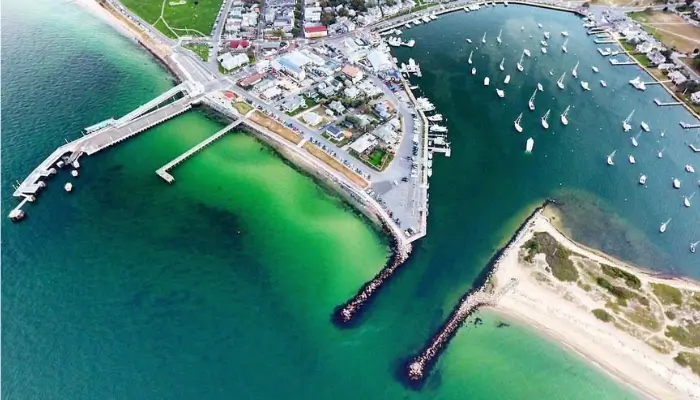
Boating Navigation Terminology
What is a Nautical Chart?
What is a Form in Boating?
What'due south the divergence between heading and bearing?
What's a Compass?
What is a mark in boating?
What does ETA stand for?
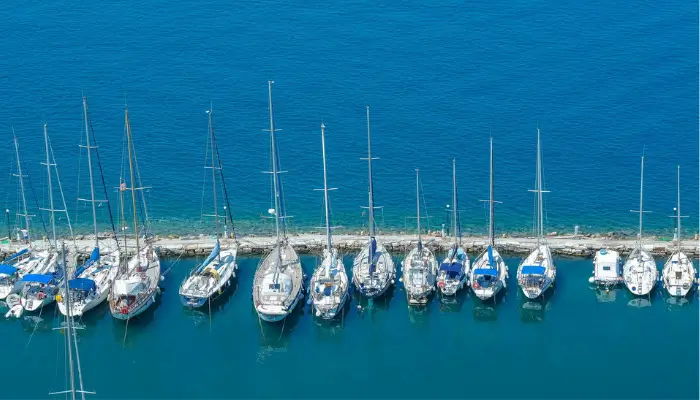
Canoeing Terms to know when docking or mooring
What does a dock hand do?
What is a hull?
What is a fender in boating?
What is a cleat?
What's the divergence between lines and ropes?
What's the difference between sheets and halyards?
What is leeway in boating?

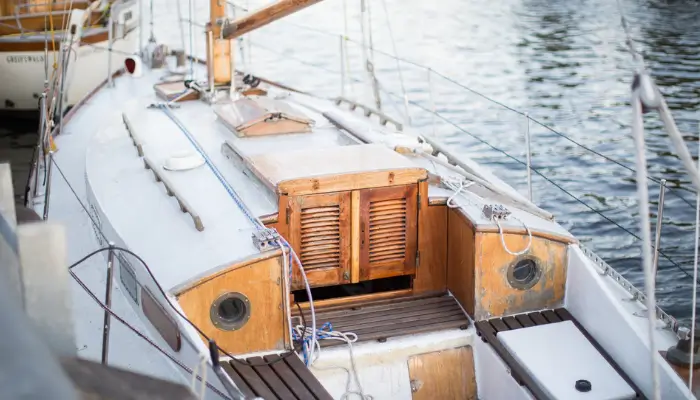
Parts of a boat to know when on deck
What is a helm?
What is a cockpit in boating?
What is forward vs. aft?
What is a boat'due south companionway?
What is a boat'south dodger?
What is a bimini top?
What is a transom?
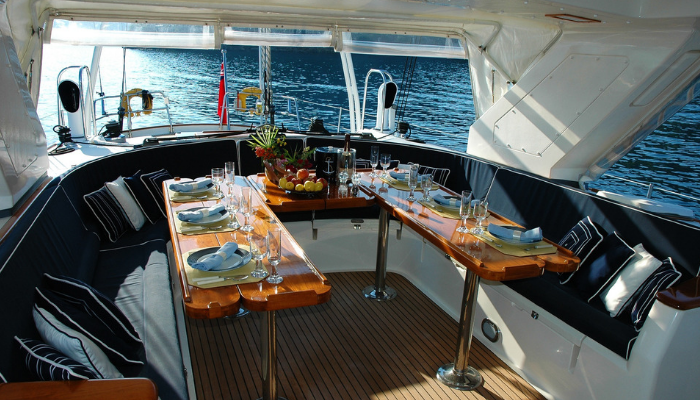
Boating Terminology to know when below deck
What is a gunkhole'southward galley?
What is a boat'south motel?
What is a boat's head?
What is a nav station in boating?
What is a boat's stow?
What is a tack vs a jibe in boating?

Source: https://blog.dockwa.com/boating-terminology-definitions
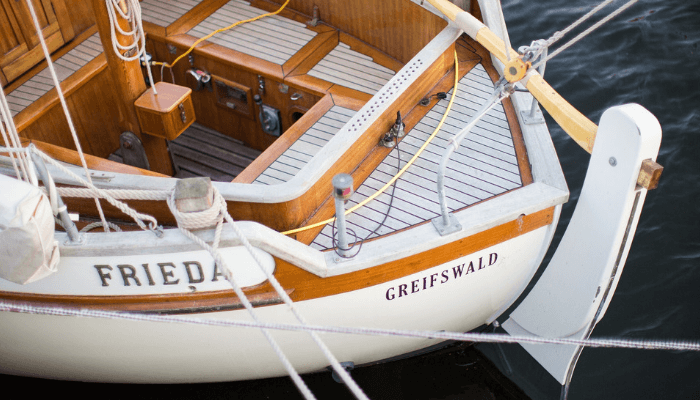
0 Response to "What s the Back of the Boat Called Again"
Post a Comment